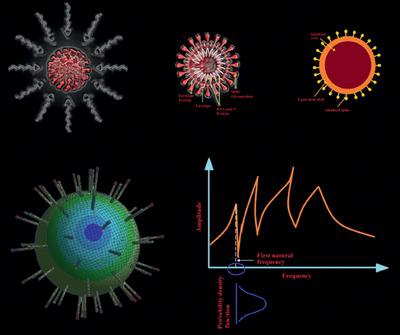当前位置:
X-MOL 学术
›
Adv. Theory Simul.
›
论文详情
Our official English website, www.x-mol.net, welcomes your
feedback! (Note: you will need to create a separate account there.)
Probing the Stochastic Dynamics of Coronaviruses: Machine Learning Assisted Deep Computational Insights with Exploitable Dimensions
Advanced Theory and Simulations ( IF 2.9 ) Pub Date : 2021-05-06 , DOI: 10.1002/adts.202000291 T. Mukhopadhyay 1 , S. Naskar 2 , K. K. Gupta 3 , R. Kumar 3 , S. Dey 3 , S. Adhikari 4
Advanced Theory and Simulations ( IF 2.9 ) Pub Date : 2021-05-06 , DOI: 10.1002/adts.202000291 T. Mukhopadhyay 1 , S. Naskar 2 , K. K. Gupta 3 , R. Kumar 3 , S. Dey 3 , S. Adhikari 4
Affiliation

|
A machine learning assisted efficient, yet comprehensive characterization of the dynamics of coronaviruses, in conjunction with finite element (FE) approach, is presented. Without affecting the accuracy of prediction in low-frequency vibration analysis, an equivalent model for the FE analysis is proposed, based on which the natural frequencies corresponding to first three non-rigid modes are analyzed. To quantify the inherent system-uncertainty efficiently, Monte Carlo simulation is proposed in conjunction with the machine learning based FE computational framework for obtaining complete probabilistic descriptions considering both individual and compound effect of stochasticity. A variance based sensitivity analysis is carried out to enumerate the relative significance of different material parameters corresponding to various constituting parts of the coronavirus structure. Using the modal characteristics like natural frequencies and mode shapes of the virus structure including their stochastic bounds, it is possible to readily identify coronaviruses by comparing the experimentally measured dynamic responses in terms of the peaks of frequency response function. Results from this first of its kind study on coronaviruses along with the proposed generic machine learning based approach will accelerate the detection of viruses and create efficient pathways toward future inventions leading to cure and containment in the field of virology.
中文翻译:

探索冠状病毒的随机动力学:机器学习辅助具有可利用维度的深度计算洞察力
结合有限元 (FE) 方法,提出了一种机器学习辅助有效且全面的冠状病毒动力学表征。在不影响低频振动分析预测精度的前提下,提出了有限元分析的等效模型,在此基础上分析了前三个非刚性模态对应的固有频率。为了有效地量化固有的系统不确定性,蒙特卡罗模拟结合基于机器学习的有限元计算框架被提出,以获得完整的概率描述,同时考虑随机性的个体和复合效应。进行基于方差的敏感性分析,以列举与冠状病毒结构的各个组成部分相对应的不同材料参数的相对显着性。使用病毒结构的固有频率和模式形状(包括其随机边界)等模态特征,可以通过比较实验测量的频率响应函数峰值动态响应来轻松识别冠状病毒。这项对冠状病毒的同类研究的结果以及提出的基于通用机器学习的方法将加速病毒的检测,并为未来的发明创造有效途径,从而导致病毒学领域的治愈和遏制。使用病毒结构的固有频率和模式形状(包括其随机边界)等模态特征,可以通过比较实验测量的频率响应函数峰值动态响应来轻松识别冠状病毒。这项对冠状病毒的同类研究的结果以及提出的基于通用机器学习的方法将加速病毒的检测,并为未来的发明创造有效途径,从而导致病毒学领域的治愈和遏制。使用病毒结构的固有频率和模式形状(包括其随机边界)等模态特征,可以通过比较实验测量的频率响应函数峰值动态响应来轻松识别冠状病毒。这项对冠状病毒的同类研究的结果以及提出的基于通用机器学习的方法将加速病毒的检测,并为未来的发明创造有效途径,从而导致病毒学领域的治愈和遏制。
更新日期:2021-07-14
中文翻译:

探索冠状病毒的随机动力学:机器学习辅助具有可利用维度的深度计算洞察力
结合有限元 (FE) 方法,提出了一种机器学习辅助有效且全面的冠状病毒动力学表征。在不影响低频振动分析预测精度的前提下,提出了有限元分析的等效模型,在此基础上分析了前三个非刚性模态对应的固有频率。为了有效地量化固有的系统不确定性,蒙特卡罗模拟结合基于机器学习的有限元计算框架被提出,以获得完整的概率描述,同时考虑随机性的个体和复合效应。进行基于方差的敏感性分析,以列举与冠状病毒结构的各个组成部分相对应的不同材料参数的相对显着性。使用病毒结构的固有频率和模式形状(包括其随机边界)等模态特征,可以通过比较实验测量的频率响应函数峰值动态响应来轻松识别冠状病毒。这项对冠状病毒的同类研究的结果以及提出的基于通用机器学习的方法将加速病毒的检测,并为未来的发明创造有效途径,从而导致病毒学领域的治愈和遏制。使用病毒结构的固有频率和模式形状(包括其随机边界)等模态特征,可以通过比较实验测量的频率响应函数峰值动态响应来轻松识别冠状病毒。这项对冠状病毒的同类研究的结果以及提出的基于通用机器学习的方法将加速病毒的检测,并为未来的发明创造有效途径,从而导致病毒学领域的治愈和遏制。使用病毒结构的固有频率和模式形状(包括其随机边界)等模态特征,可以通过比较实验测量的频率响应函数峰值动态响应来轻松识别冠状病毒。这项对冠状病毒的同类研究的结果以及提出的基于通用机器学习的方法将加速病毒的检测,并为未来的发明创造有效途径,从而导致病毒学领域的治愈和遏制。











































 京公网安备 11010802027423号
京公网安备 11010802027423号